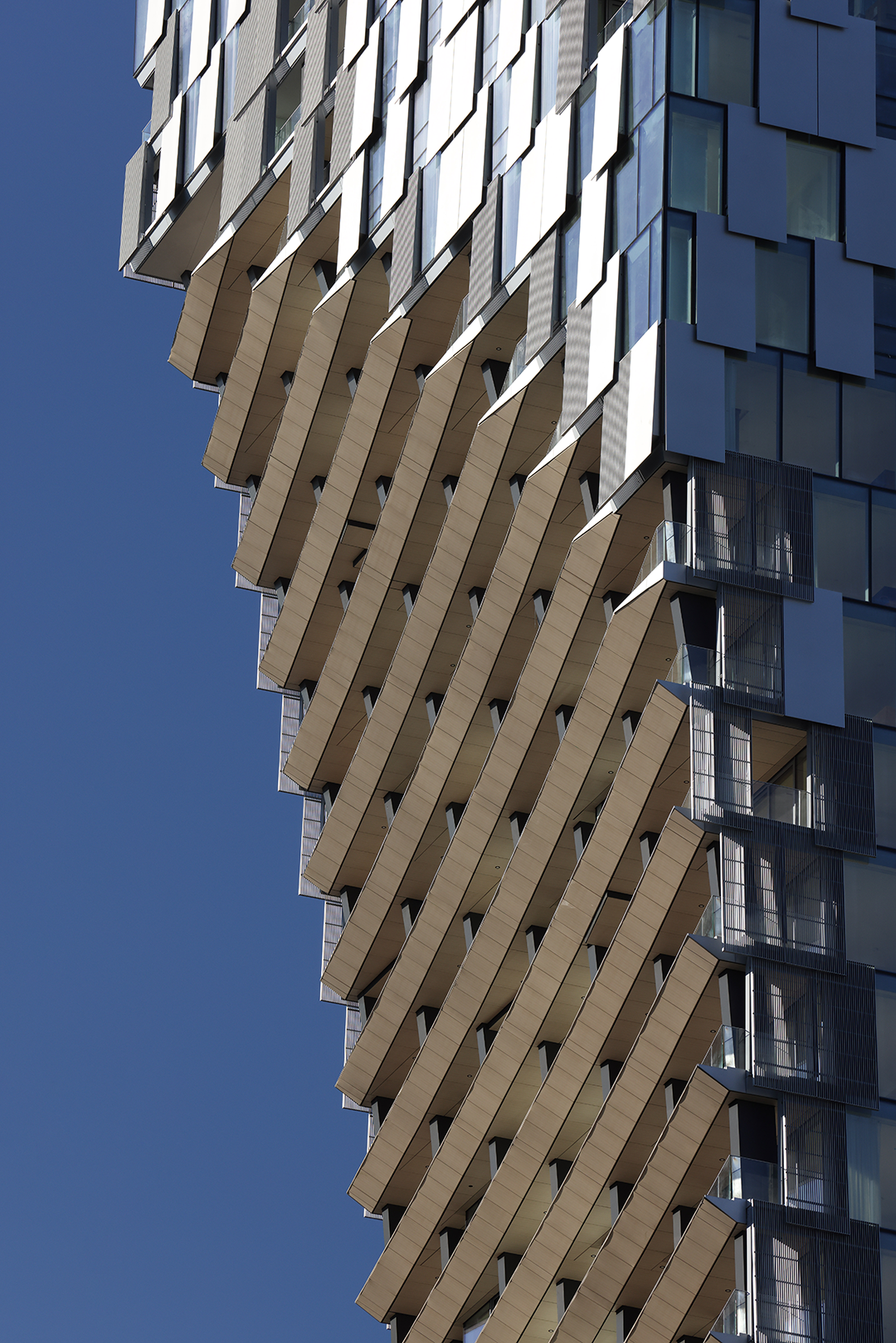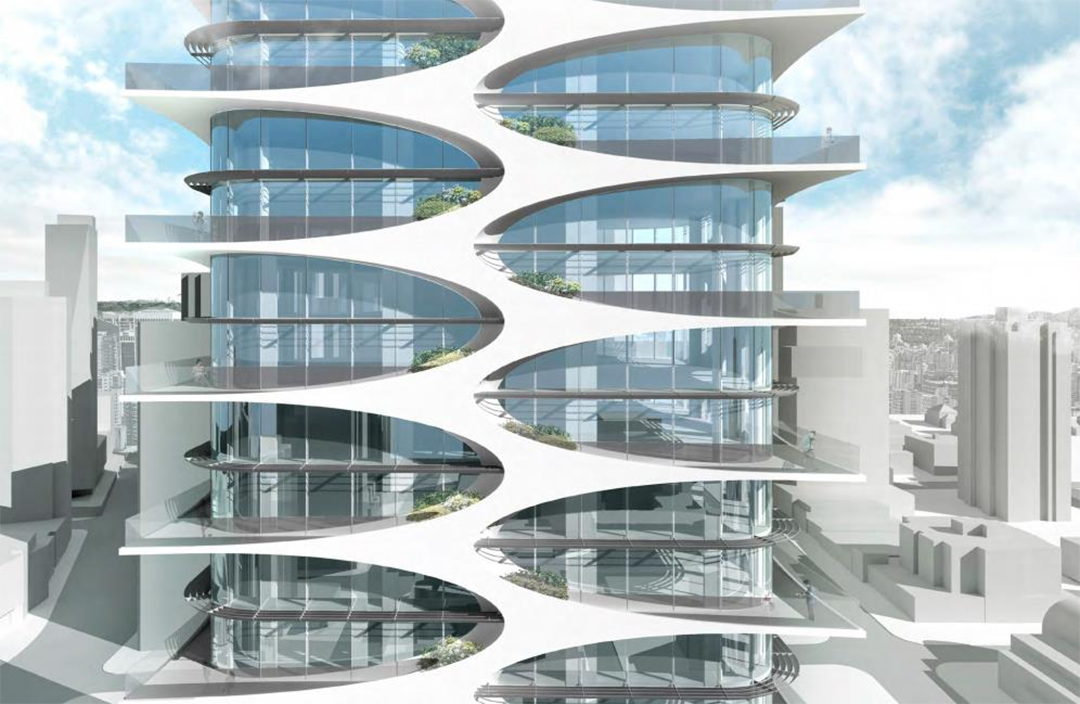

这是一座高层公寓,位于温哥华高豪港区逐渐向北延伸至斯坦利公园的过渡区域。设计希望创造与周围环境紧密相连的一种新的摩天大楼,而不是将其作为一个孤立的物体。
This is a high-rise condominium, located where Vancouver's Coal Harbour District tapers north toward Stanley Park. We wanted to create a new kind of skyscraper not as an isolated object, but instead defined by strong relationships to its setting.

设计还希望自然能够贯穿整个底层。在这里,一个覆盖着青苔的露天剧场邀请人们在如云层一般的木构装置下欣赏音乐和戏剧表演,也为城市提供了一个自然的文化活动场所。
We also wanted nature to be present throughout the ground floor. Here, an open-air moss-covered amphitheater invites people under a kigumi cloud for musical and theatrical performances, engaging the city with a natural place for cultural activity.




塔楼富有特色的轮廓是对城市和周围广阔自然环境的回应。优雅宽阔的大弧线基于塔楼与邻近建筑、海港和远处山脉的视线通廊方向设计,雕刻出建筑体量。
The tower's characteristic silhouette results from its response to the city and to the vast natural surroundings. Large, sweeping arcs carve the building volume according to view corridors of the adjacent buildings, toward the Harbour and the mountains beyond.

这些大弧线也透露出建筑内部柔和轻松的氛围。阳台的布置顺应着建筑轮廓,将屋檐下的木质纹理展露无遗。这一侧每套房子里的住户都可以在阳台享受户外生活,与自然建立直接联系。
These big scoops reveal the softer interiors of the building, yielding balconies throughout, and exposing the wood patterning beneath the eaves. Outdoor living is immediately accessible for each unit.





而在弧线以外的部分,垂直的外墙显得更为硬朗,立面由透明玻璃、不透明铝板和半透明格栅板组成,对阳光和来自西北太平洋不断变化的光线起到反射和过滤作用。
Elsewhere, the harder vertical facades comprise units of glass, opaque aluminum and grille panels, reflecting and filtering the ever-changing Pacific Northwest light.


这座建筑是温哥华天际线上一个高大而独特的存在,但由于它是由许多较小的部分组成,消减了尺度感。建筑中任何两处看见的景观都不相同,它的形状也难以捉摸。
It is a tall, distinctive presence on the skyline, but made of visibly smaller pieces. No two views of the building are the same, its shape elusive.


Alberni街其他高层住宅方案
1515 Alberni
设计:Buro Ole Scheeren


1700 Alberni
设计:Heatherwick Studio


1684 Alberni
设计:Revery Architecture


1818 Alberni
设计:Foad Rafii


1550 Alberni 设计图纸 ▽






1550 Alberni
完整项目信息
TEAM
Balazs Bognar, Richard Nelson, Kevin Clement, Nicolas Cazali, Jagoda Joanna Krawczyk, Yasemin Sahiner, Nicolas Guichard, Tomohiro Matsunaga, Martina Bandolin, Colby Perrine, John Xianfeng Jiang, Michael Sypkens, Esteban Ochogavia, Shinya Tohyama, Mira Yung, Yu Tsuji, Takumi Saikawa, Andrea Lizakova, Wenyu Wu, Fumiya Kaneko
COOPERATION
Glotman Simpson Engineers
JOINT DESIGN
Merrick Architecture
EXTERIOR
PFS Studio
OTHERS
Merrick Architecture, PFS Studio, Glotman Simpson Engineers
PHOTOGRAPHY
©︎Ema Peter, ©︎George Handford, ©︎Jonathon Folke, ©︎Lukas Dong
本文编排版权归有方空间所有。项目图片及英文设计说明由Kengo Kuma & Associates提供并授权有方发布。延伸阅读部分图片来自网络,版权归原作者或来源机构所有。欢迎转发,禁止以有方编辑版本转载。若有涉及版权问题,请联系邮箱info@archiposition.com
上一篇:木材并非最优选择?UNStudio最新设计Kyklos大楼采用混合结构将有效减少碳排放
下一篇:建言|对话王灏:以木构精神延续当代人地关系,建筑就是要诚挚地表达这个时代